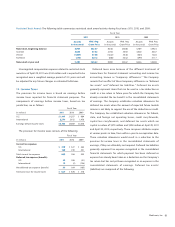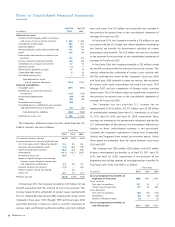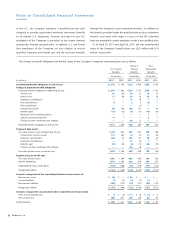Medtronic 2011 Annual Report Download - page 95
Download and view the complete annual report
Please find page 95 of the 2011 Medtronic annual report below. You can navigate through the pages in the report by either clicking on the pages listed below, or by using the keyword search tool below to find specific information within the annual report.
91
Medtronic, Inc.
T
and ending balances of post-retirement benefit assets measured
at fair value that used significant unobservable inputs (Level 3):
(in millions)
April 2 9,
2011
April 30,
2010
Beginning Balance $ 89 $69
Total realized gains/(losses) and other-than-
temporary impairment losses included
in earnings 1 (2)
Total unrealized gains included in accumulated
other comprehensive loss 12 19
Purchases, issuances, and settlements — 3
Ending Balance $102 $89
Retirement Benefit Plan Funding It is the Company’s policy
to fund retirement costs within the limits of allowable tax
deductions. During fiscal year 2011, the Company made
discretionary contributions of approximately $180 million to the
U.S. pension plan and approximately $28 million to fund post-
retirement benefits. Internationally, the Company contributed
approximately $102 million for pension benefits during fiscal year
2011. During fiscal year 2012, the Company anticipates that its
contribution for pension benefits and post-retirement benefits
will be consistent with those contributions made during the prior
fiscal year 2010. Based on the guidelines under the U.S. Employee
Retirement Income Security Act of 1974 and the various guidelines
which govern the plans outside the U.S., the majority of
anticipated fiscal year 2012 contributions will be discretionary.
Retiree benefit payments, which reflect expected future service,
are anticipated to be paid as follows:
(in millions)
U.S.
Pension
Benefits
Non-U.S.
Pension
Benefits
Post-Retirement
Benefits
Fiscal Year
Gross
Payments
Gross
Payments
Gross
Payments
Gross
Medicare
Part D
Receipts
2012 $ 43 $ 30 $ 10 $ 1
2013 47 21 11 1
2014 52 23 13 1
2015 57 24 15 1
2016 63 26 17 2
2017–2021 406 153 125 16
Total $668 $277 $191 $22
I
Protection and Affordable Care Act (PPACA) and the Reconciliation
Act. Included among the major provisions of these laws is a
change in the tax treatment of the Medicare Part D subsidy. The
subsidy came into existence with the enactment of the Medicare
Modernization Act (MMA) in 2003 and is available to sponsors of
retiree health benefit plans with a prescription drug benefit that
is actuarially equivalent to the benefit provided by the Medicare
Part D program. Prior to the enactment of the PPACA and the
Reconciliation Act, the Company was allowed to deduct the full
cost of its retiree drug plans without reduction for subsidies
received.
Under U.S. GAAP, the Company records a liability on its balance
sheet for the expected cost of earned future retiree health
benefits. When the MMA was enacted in 2003, this liability was
reduced to reflect expected future subsidies from the Medicare
Part D program. In addition, the Company recorded a reduction
to the deferred tax liability on the balance sheet for the value of
future tax deductions for these retiree health benefits. Each year,
as additional benefits are earned and benefit payments are made,
the Company adjusts the post-retirement benefits liability and
deferred tax liability.
After the passage of the PPACA and the Reconciliation Act, the
Company must reduce the tax deduction for retiree drug benefits
paid by the amount of the Medicare Part D subsidy beginning
in 2013. U.S. GAAP requires the impact of a change in tax law to
be recognized immediately in the income statement in the period
that includes the enactment date, regardless of the effective date
of the change in tax law. As a result of this change in tax law,
the Company recorded a non-cash charge of $15 million in fiscal
year 2010 to increase the deferred tax liability. As a result of
this legislation, the Company will be evaluating prospective
changes to the active and retiree health care benefits offered
by the Company.
In August 2006, the Pension Protection Act was signed into
law in the U.S. The Pension Protection Act replaces the funding
requirements for defined benefit pension plans by subjecting
defined benefit plans to 100 percent of the current liability
funding target. Defined benefit plans with a funding status of less
than 80 percent of the current liability are defined as being “at
risk.” The Pension Protection Act was effective for the 2008 plan
year. The Company’s U.S. qualified defined benefit plans are
funded in excess of 80 percent, and therefore the Company
expects that the plans will not be subject to the “at risk” funding
requirements of the Pension Protection Act and that the law will
not have a material impact on future contributions.
























